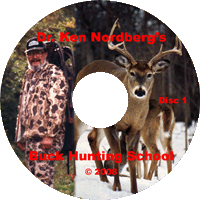How to Properly Field Dress a Bear
By
Dr. Ken Nordberg
Photos by Jene K. Armstrong
This is one of thousands of articles authored by Dr. Ken Nordberg and first published in outdoor magazines. This updated article was first printed in Bear Hunting Magazine, March/April 2002 edition. The original 2002 article is largely taken from Dr. Ken Nordberg's book, Do-It-Yourself Black Bear Baiting and Hunting—2nd Edition—which is currently out-of-print.
(Copyright 2013, Dr. Ken Nordberg)
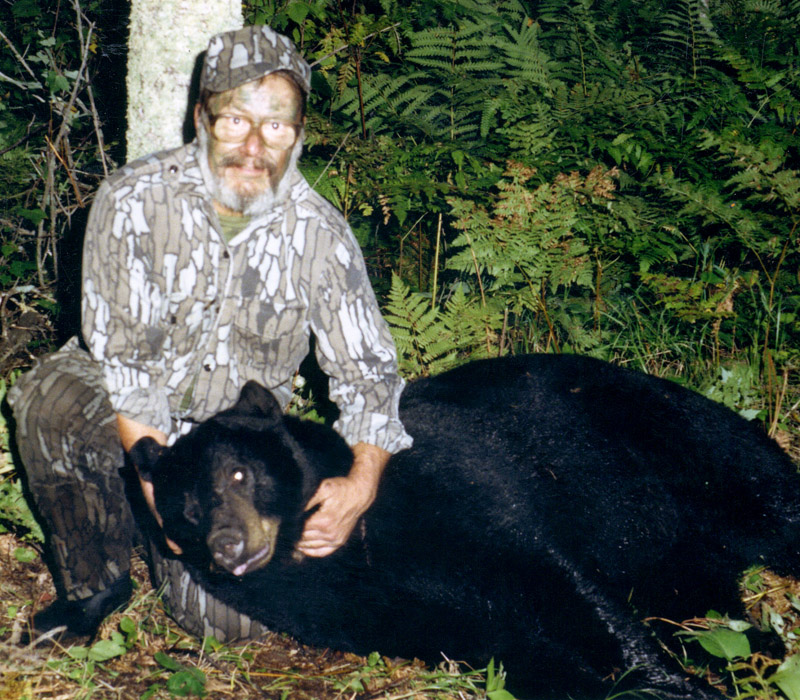
Dr. Ken Nordberg with a Trophy-Class Black Bear.
[Note from John Nordberg. My father has a video of him
field dressing a black bear in his Bear Hunting School DVDs.]
The black bear you have just harvested will be every bit as much trouble as a fur covered carton containing 250-500 pounds of 100-degree milk. Now, you must quickly remove innards capable of seriously contaminating the meat (the most flavorsome of all wild meats in my estimation), move the carcass to your camp or vehicle without damaging that valuable pelt, and cool the carcass and pelt before they spoil. Whatever the current weather conditions, a 250+ pound bear will spoil about as quickly as a 250+ pound carton of 100-degree milk. When the air temperature is about 40 degrees F., a field dressed bear carcass and its pelt will begin to spoil in about 12 hours; at 50 degrees F., about six hours; at 60 degrees F., about three hours. Time, therefore, is of the essence.
Before you kneel down to begin field dressing your bear, think about what that bear has been eating: your awful-smelling, fly and maggot-infested bait. Would you eat a steak that has been dipped in bear bait? Would you get sick if you did? Well encased within your bear's stomach and intestines is plenty of undigested, partially digested and fully digested bear bait. If any of it escapes into the bear's chest or abdominal cavity as you field dress your bear, you will be eating bear meat that has been dipped in bear bait. Obviously, then, avoiding the escape of the contents of the bear's stomach and gastrointestinal tract must be your number-one priority when field dressing a bear.
Proper field dressing of a bear requires skill and knowledge; considerably more than is demonstrated by the average whitetail hunter when field dressing a deer. Because whitetails are herbivores and because they are generally hunted in cooler weather, deer hunters can field dress deer improperly without serious consequences. Not bear hunters. It must be done exactly right.
As you will discover, compared to the contents of the chest and abdomen of a white-tailed deer, the contents of the chest and abdomen of a black bear are surprisingly small. Lungs of black bears are considerably smaller than those of whitetails of the same weight, and black bears have much smaller stomachs, not being four-chambered like stomachs of whitetails. The viscera and blood of a whitetail accounts for 22-23% of its total body weight. The viscera and blood of a black bear accounts for only about 10-15% of its total weight.
Field dressing serves three important functions:
- it reduces the weight of the bear, making it easier to transport,
- it removes substances potentially ruinous to the meat and
- it enables the carcass to cool more quickly and thoroughly, vital to the preservation of both the meat and pelt.
All you need in the way of tools for field dressing is a short-bladed knife, some rope, a short length of stout string and some paper toweling to wipe your hands and lower arms when you are done. If it is dark, you will also need light provided by a lantern and/or flashlight.
Your knife blade should be sharp and of top quality. If it is not, your are going to do plenty of grunting and cussing while cutting through bear hide. Bear hide comes close to moose hide for toughness, and like moose hide, it will dull a lesser blade in a hurry. The blade should be no longer than 2 1/2 to 4 inches. A short blade is safer, it works better in small places such as in the chest cavity and it puts your hand closer to your work, giving you greater control (imagine a surgeon trying to remove your appendix with one of those monstrous, Bowie-type knives carried by many deer hunters).
Ten steps to properly field dressing a black bear are as follows:
Step 1: Roll the bear onto its back. With hind legs spread (tied to adjacent tree trunks with rope or held by hunting partners), cut through the hide around the bear's penis and testicles (or vulva on a sow), separating the penis and testicles from underlying body tissues down to the pelvic canal from which the shaft of the penis (or sow's vagina) and anus emerge. Do not sever the penis or testicles from the carcass (avoid cutting through a sow's vagina as the vulva is separated from the underlying tissues).
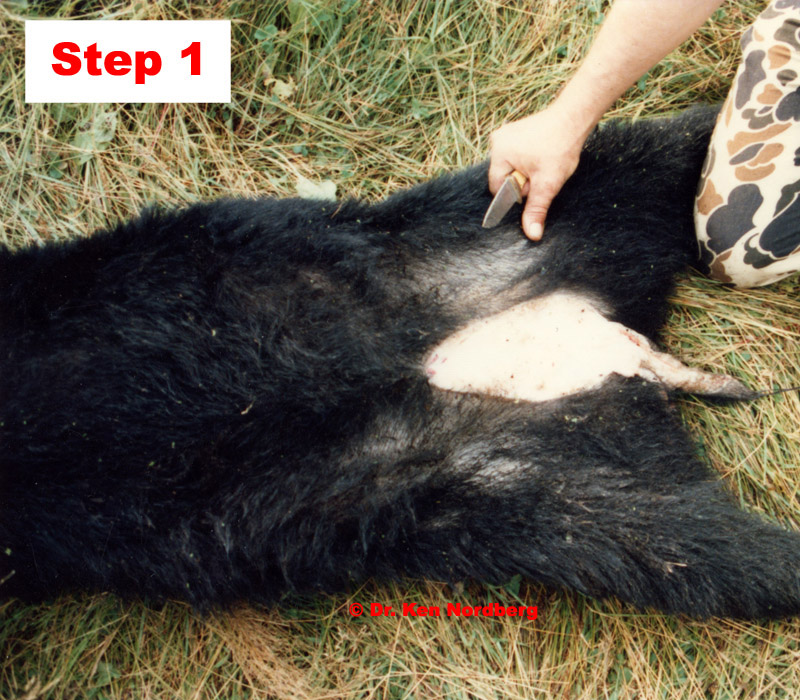
Step 1 Field Dressing a Black Bear
Step 2: Continue the cuts made through the hide on either side of the penis and testicles (or vulva) down and completely around the bear's anus. Using the tip of your knife and fingers, carefully separate the anus, rectum and penis shaft (or vagina) from the surrounding tissues about four inches into the bone-surrounded pelvic canal. Where it wraps around the pubic bone, you will find the penis shaft is attached by strong, tendon-like tissue. Using your knife, slice through this tissue close to the bone. Once severed, much of the connective tissue about that portion of the penis that passes through the bony pelvic canal and much of that about the rectum can be separated by inserting a finger, curling it alongside the pelvic bones and pulling outward. Connective tissues that will not separate via this technique should be carefully severed with the tip of your knife blade.
Step 3: Now grasp the separated base of the penis (or vagina) and rectum firmly in your left hand and stretch them outward from the pelvic canal.
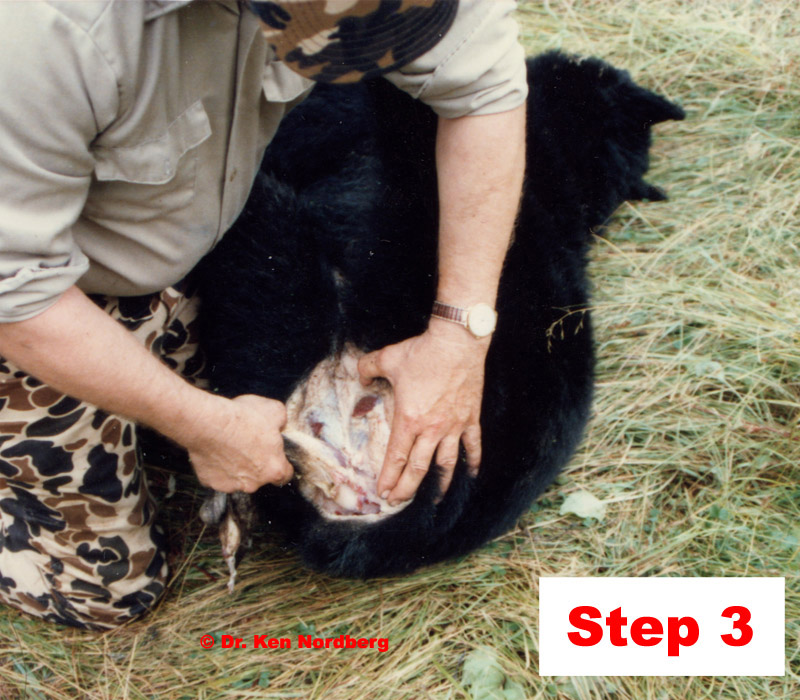
Step 3 Field Dressing a Black Bear
Step 4: Firmly wrap your stout string twice around the out-stretched base of the penis (or vagina) and rectum and tie the ends tightly with a square knot. Now urine and feces cannot escape from the bear's urinary bladder or rectum during the rest of the field dressing process.
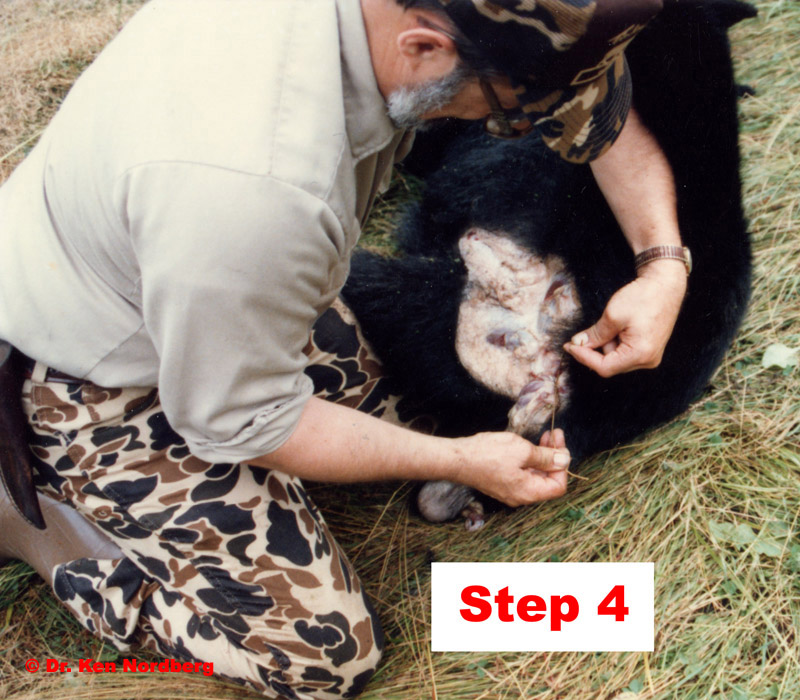
Step 4 Field Dressing a Black Bear
Step 5: With the blade of your knife held upright, extend the cut made through the bear's hide in the pelvic area up the center of the bear's abdomen to the base of the breastbone (sternum), slicing upward through the hide only. Spreading the incision open as you go, carefully slice down through the fatty tissue and muscle overlying the smooth, white peritoneum (the thin sack that contains the bowels).
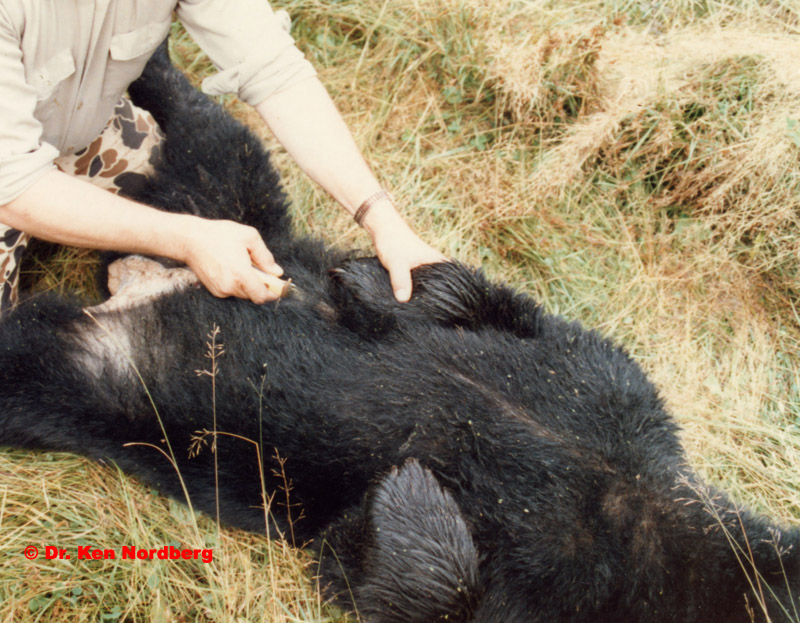
Cutting upwards while field dressing a black bear.

Step 5a Now the hide is cut.
Next, using the tip of your knife, carefully cut down through the peritoneum at the lower end of the abdominal cavity (just forward of the pubic bone that crosses between the hind legs). A bowel may immediately pop up through this opening. Be careful not to cut into it. Kneel on the left side of the bear and insert two fingers of your left hand into this incision, curl them back at the second knuckle and lift the peritoneum up and away from the underlying bowels. Insert the tip of your knife, blade up, between your fingers, into this opening, be careful to avoid piercing intestines. Now cut carefully toward the breastbone as your left fingers slide along on either side of the blade, lifting the peritoneum away from the bowels. The abdominal cavity is now open.

Step 5b Now the peritoneum is cut.
Step 6: Spread open the abdominal incision. Reach in and gently pull the bear's liver and stomach away from tissues below the lower end of the breastbone to expose the bear's diaphragm (the thin layer of muscle that separates the chest cavity from the abdominal cavity). This muscle must be severed from the body cavity completely around the inner surfaces of the lowest ribs on both sides, breastbone to backbone. In a fat bear, this can be difficult to accomplish. Not uncommonly, the bear must be rolled a bit to one side and the other in order to move the liver and stomach enough to see the diaphragm on either side. If the entire diaphragm cannot be cut without danger of cutting open the stomach, leave the lower portion of the diaphragm (near the spine) intact at this point, finishing it up after the bear's lungs and heart are pulled from the chest cavity, making the lower diaphragm easier to see and reach.

Step 6 for Field Dressing a Black Bear (Cutting the diaphragm.)
Step 7: You should now be able to see, somewhat, into the chest cavity. If you shot your bear properly, the bear's lungs will be collapsed and the chest cavity will be half full of blood. Roll up your sleeves and reach forward, toward the neck, into the chest cavity with both hands, knife in one. [This is a good reason for using a shorter knife.] Caution: If you shot your bear with an arrow and the arrow did not pass entirely through the chest cavity, be sure to remove it before reaching blindly into the chest cavity. A broadhead can make a nasty cut on your hands. Use your free hand to locate and grasp the bundle of tubes emerging into the front part of the chest cavity from the bear's neck. One tube in that bundle is easy to identify via feel. It will feel like a firm plastic tube with projecting rings. This is the bear's trachea or windpipe. On both sides and beneath the trachea, you will feel other tubes, soft to your grasp. The big one beneath the trachea is the esophagus, the tube connecting the bear's mouth to its stomach. The smaller tubes are major blood vessels coursing to and from the bear's head and neck. Firmly grasp this bundle of tubes in one hand, pulling on it a bit as you carefully ease your knife (blade down and at a right angle to the spine) to a point halfway between your hand holding the bundle of tubes and the base of the neck. Now, using short strokes, cut down through the bundle of tubes until it is fully severed. Do not let go of it at this point. Ease your knife hand out and then pull the severed bundle of tubes from the chest cavity. Emerging from the chest cavity, attached to those tubes, will be the bear's heart and lungs. Just like that, the bear's chest cavity will be empty, except for some blood.

Step 7 Cutting the Trachea and Esophagus
Step 8: Now roll the bear carcass to one side. By partially rolling loose viscera from the abdominal cavity and having a partner lift up on the top edge of the abdominal incision, you should be able to see and cut through, along the ribs, any of the diaphragm you could not get to before. You will probably have to roll the bear to the other side to finish the diaphragm cut. Once the diaphragm is completely free, the bear's stomach and intestines will seem more inclined to emerge from the abdominal cavity, but not fully. They are still attached to something somewhere. What they are attached to is a curtain of thin tissue (omentum) which is attached to the spine in the forward half of the abdominal cavity. While the stomach and intestines are partially rolled from the abdominal cavity (carcass lying on one side), even if you cannot see this spinal attachment, you should nonetheless easily locate it with your hands. Carefully reach in over the stomach and liver with both hands, knife in one hand and the other hand pressing tissues aside to expose the omentum where it attaches at the lumpy and bony spine. Now carefully cut through these tissues where they attach to the spine. As you do this, you will note the stomach and intestines are falling free from the inner carcass. As you cut through the omentum, avoid cutting into the tenderloins (long, thin muscles located on either side of the spine).
[Note from John: While I knew this, I still once made the mistake of "blindly" pulling out the tenderloins by hand. In my case, they were only 1 3/4" inches in diameter. I didn't even notice my mistake until I got back to camp. It is a shame to leave the tenderloins in the gut pile. Don't make my mistake. It is likely, while field dressing, you will not be able to see the tenderloins. Just remember, the tenderloins, feel like "tubes" of muscle run immediately parallel to each side of the spine.]
Once the 8-12 inch-long section of omentum is severed, the entire mass of the viscera will roll free from the chest and abdominal cavities, except the intestine and other tubes that course back toward the anus through the inner end of the bony pelvic girdle between the bear's hind legs.
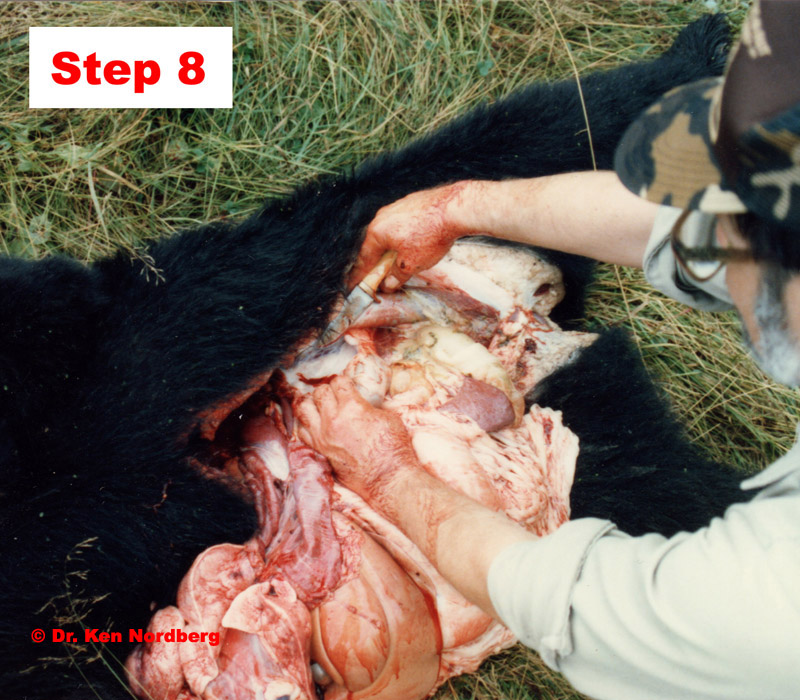
Step 8 Field Dressing a Black Bear (Cutting the Omentum)
Step 9: With most of the viscera removed (intestine and other tubes intact where they enter the pelvic canal inside), roll the bear carcass to its back so you can see what you are going to do next. You do not want to goof up here. Using fingers, and your knife tip only if necessary, carefully separate the tissues surrounding the intestine and other tubes from the inner end of the bony pelvic canal. Usually about four inches in is enough, but you might find it necessary to separate pelvic tissues from the bony pelvis another inch or two at both ends of the canal. Now firmly grasp the bowel and other tissues right next to where they enter the inner end of the pelvic canal and slowly and firmly pull these tissues toward the head end of the carcass. The tied rectum and penis shaft (or vagina) should soon begin sliding into and through the pelvic canal. If they do not, stop and carefully separate surrounding tissues more deeply at both ends of the pelvic canal. Whatever you do, do not cut into the intestine or the urethra (thin tube from the urinary bladder to external penis or vulva).
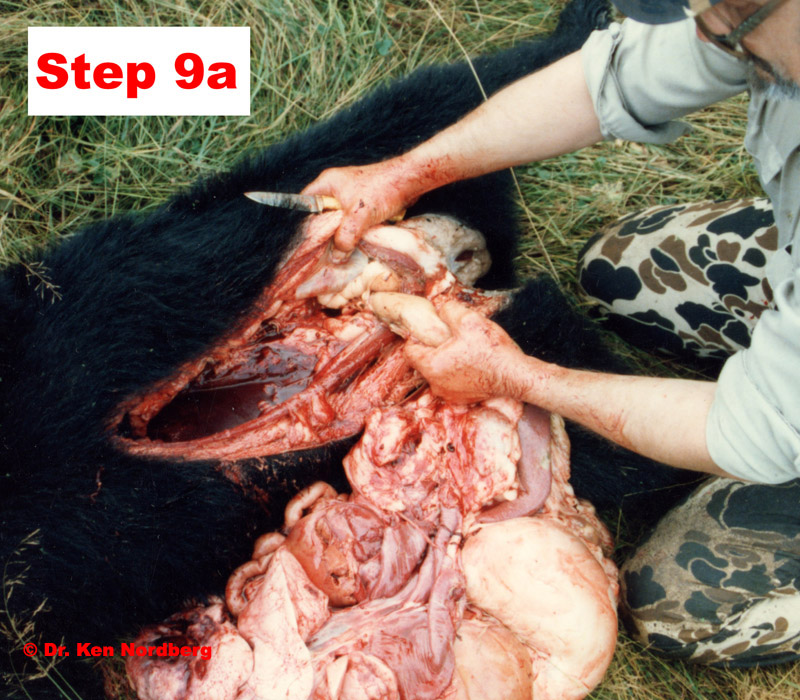
Step 9a Pulling the tied rectum and penis shaft through the pelvic canal.
Once the tied rectum and penis shaft (or vulva) slides into and entirely through the pelvic canal, the entire visceral mass can be rolled free from the carcass.

Step 9b Do not cut it off! Tie it off and pull it through.
Step 10: Now roll the bear carcass back-side-up, legs spread to both sides, head end slanted uphill if possible, thus allowing the blood inside the carcass to drain out.
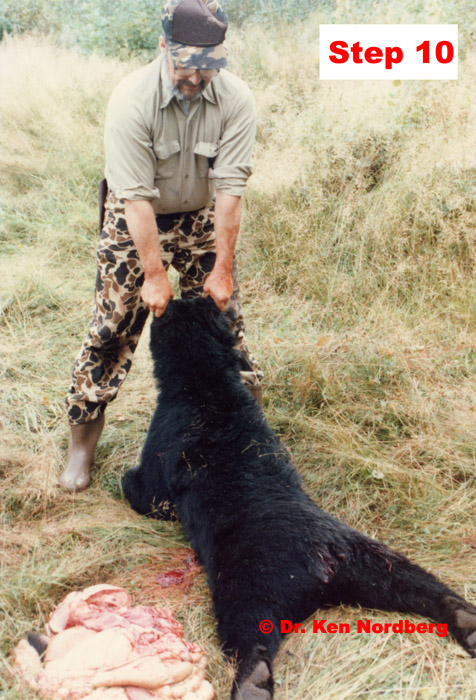
Step 10 Positioning the bear so it will drain.
Do not plan to eat the black bear liver. As you will see, a black bear's liver is strange in appearance (pale in color and/or yellow). It is so loaded with vitamin B that it can be toxic. Leave it for the birds and other wild creatures.
Okay, wipe your hands, arms and knife. This job is done.
[Note from John: Over the years, a few knives have been left at or in gut piles. All but one were found. That one — my father's prized knife — is still in the woods somewhere. You can see his lost knife in the photos above. It looked like my knife — but with a white handle. They were custom made with surgical steel by a long-time friend of my father's, a surgeon from Georgia, Dr. Steve Fennel. My knife is numbered, "003." Just remember, before you drag your trophy back to camp, make sure you have got your weapon, knife, camera, or any other valuables. In the excitement, they are easy to forget. ;)]
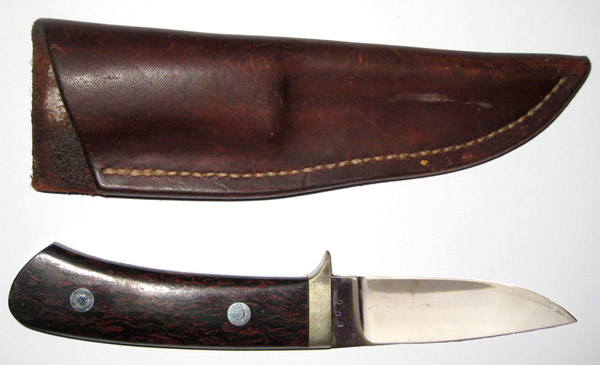
John's Knife
Good Luck Hunting,
Doc
[Note from John Nordberg. If you would like to see a video demonstrating how to field dress a black bear, then my father has video — of him — field dressing a black bear in his Bear Hunting School DVDs. Please order, Dr. Ken Nordberg's Bear Hunting School DVDs.]


A Black Bear carcass hanging with its cavity propped open with pointed sticks.
(Doc has placed this article on his web site for his bear hunter fans, partly because his bear books are currently out-of-print.)


















